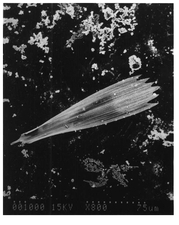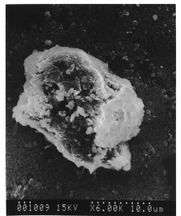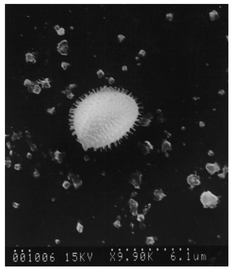The Source Field Investigations (29 page)
Read The Source Field Investigations Online
Authors: David Wilcock

An even more stunning discovery was made by British astronomers Sir Fred Hoyle and Dr. Nalin Chandra Wickramasinghe, who explored the composition of galactic dust in the 1960s. More and more, the evidence suggested that the vast majority of dust throughout the entire galaxy—some 99.9 percent
13
—is actually freeze-dried bacteria. This discovery began when Hoyle and Wickramasinghe studied the infrared light from the dust in our galaxy, and concluded that these dust grains had to be 70 percent hollow on the inside. Bacteria have a hard outer cell wall and a softer interior. They were stunned when they found out that freeze-dried bacteria are also 70 percent hollow on the inside. By simply assuming that galactic dust grains were freeze-dried bacteria, they found a perfect fit to their observations.
14
13
—is actually freeze-dried bacteria. This discovery began when Hoyle and Wickramasinghe studied the infrared light from the dust in our galaxy, and concluded that these dust grains had to be 70 percent hollow on the inside. Bacteria have a hard outer cell wall and a softer interior. They were stunned when they found out that freeze-dried bacteria are also 70 percent hollow on the inside. By simply assuming that galactic dust grains were freeze-dried bacteria, they found a perfect fit to their observations.
14
This led them to an utterly stunning conclusion: “Interstellar grains must surely be bacteria—albeit freeze-dried, perhaps mostly dead. At the very least this was a hypothesis that had to be explored.” In a lecture from April 15, 1980, Hoyle spelled it all out.
Microbiology may be said to have had its beginnings in the nineteen forties. A new world of the most astonishing complexity began then to be revealed. In retrospect I find it remarkable that microbiologists did not at once recognize that the world into which they had penetrated had of necessity to be of a cosmic order. I suspect that the cosmic quality of microbiology will seem as obvious to future generations as the Sun being the centre of our solar system seems obvious to the present generation.
15
15
Some thirty years later, as I write this book, that predicted change in scientific thought has obviously still not arrived. Most scientists who even bother to write about interstellar bacteria still try to stick with the comfortable idea that they evolved by Darwinian mutation, freeze-dried in space, and then crashed to earth where they then seeded all life. It’s a much greater step to realize that bacteria are everywhere, because that’s what the Universe does—create life. If this is true, then how could we possibly have missed such a stunning discovery in the history of science?
In his noteworthy book
Sparks of Life,
Harvard professor James Strick revealed that there was an extensive conspiracy in the 1800s to suppress any scientific discoveries of microbes that appeared spontaneously, from nonliving material, rather than through allegedly “random Darwinian mutation.”
16
Dr. Strick clarified his position at a 2003 conference held by the Wilhelm Reich institute, and it was written up and published online by Jack Flannel.
17
In the 1800s, the French Academy of Sciences offered prize money to any scientist who could conclusively prove that life was either spontaneous or random—and Louis Pasteur won the contest. When you see a carton of milk that says it is pasteurized, this means it was cooked to kill all the bacteria—and this process was named after Louis Pasteur. The problem is that Pasteur’s competitors did get life-forms to grow out of nonliving environments—such as by using preparations of hay that had been totally sterilized in water. Pasteur simply refused to repeat these experiments. It’s even more disappointing that Pasteur found life that spontaneously appeared in a small percentage of his own experiments, but he never even wrote about them—because he felt they had to be mistakes, and were not worth mentioning.
18
Sparks of Life,
Harvard professor James Strick revealed that there was an extensive conspiracy in the 1800s to suppress any scientific discoveries of microbes that appeared spontaneously, from nonliving material, rather than through allegedly “random Darwinian mutation.”
16
Dr. Strick clarified his position at a 2003 conference held by the Wilhelm Reich institute, and it was written up and published online by Jack Flannel.
17
In the 1800s, the French Academy of Sciences offered prize money to any scientist who could conclusively prove that life was either spontaneous or random—and Louis Pasteur won the contest. When you see a carton of milk that says it is pasteurized, this means it was cooked to kill all the bacteria—and this process was named after Louis Pasteur. The problem is that Pasteur’s competitors did get life-forms to grow out of nonliving environments—such as by using preparations of hay that had been totally sterilized in water. Pasteur simply refused to repeat these experiments. It’s even more disappointing that Pasteur found life that spontaneously appeared in a small percentage of his own experiments, but he never even wrote about them—because he felt they had to be mistakes, and were not worth mentioning.
18
The biogenesis side of the debate had evidence to support its conclusions going all the way back to 1837, with the little-known work of Andrew Crosse. At the time, electricity was a new and exciting phenomenon. Crosse wanted to try to grow crystals artificially, by zapping chemicals with a weak electrical current. Specifically, he mixed up a silicate of potash and hydrochloric acid, and then dropped a fist-size chunk of iron oxide rock into it. He then zapped the acid bath with a small battery, and hoped to find artificial silica crystals growing on the rock. Instead, he got something much, much weirder. After fourteen days, whitish specks started forming in the center of the electrified stone. Four days later, each speck was twice as large, and had six or eight tiny strands growing out from it. Each strand was longer than the speck itself.
19
19
Crosse reported what happened next in a paper he wrote for the London Electrical Society in 1837.
On the 26th day of the experiment, the objects assumed the form of perfect insects, standing erect on the bristles which they were growing. Although I regarded this as most unusual, I attached no singular significance to it until two days later, the 28th day of the experiment, when the magnifying lens showed that these things were moving their legs. I must say now that I was quite astonished. After a few more days, they detached themselves from the stone and moved about through the caustic acid solution. In the course of a few weeks, more than a hundred of them made their appearance on the oxide of iron.
20
20
The creatures appeared to be similar to the genus
Acari
, which is a form of mite: “Under a microscope I examined them, and found that the smaller ones had six legs, the larger ones had eight. Others who have examined them pronounced them to be of the genus acari, but some say they are an entirely new species.” Crosse knew he would be attacked by his colleagues, so he carefully repeated the experiment by sterilizing all the ingredients with heat in a closed container before he ever started it—but the little critters still appeared the same way.
Acari
, which is a form of mite: “Under a microscope I examined them, and found that the smaller ones had six legs, the larger ones had eight. Others who have examined them pronounced them to be of the genus acari, but some say they are an entirely new species.” Crosse knew he would be attacked by his colleagues, so he carefully repeated the experiment by sterilizing all the ingredients with heat in a closed container before he ever started it—but the little critters still appeared the same way.
Other scientists repeated Crosse’s experiment and got the same results, but according to the 1959 article by Frank Edwards that we pulled the above quotes from, they were too afraid to speak out about it.
21
This finally changed when the legendary Michael Faraday reported to the Royal Institution that he, too, had gotten these small creatures to grow under the same conditions.
22
He was not sure whether they were actually created spontaneously in the sterile solutions, or brought back to life by the electricity—but either result is a total challenge to mainstream science and biology as we now know it.
21
This finally changed when the legendary Michael Faraday reported to the Royal Institution that he, too, had gotten these small creatures to grow under the same conditions.
22
He was not sure whether they were actually created spontaneously in the sterile solutions, or brought back to life by the electricity—but either result is a total challenge to mainstream science and biology as we now know it.
Another early pioneer we briefly mentioned in chapter 1 is Wilhelm Reich. His research into orgone energy, as he called it, was dismissed as a joke. Nonetheless, given everything we’ve been uncovering in this investigation, he appears to have been on the right track. Reich concluded that orgone fills all space in the Universe, does not have mass, penetrates matter, has a pulsating movement that can be measured, has a strong attraction to water, and is accumulated naturally in organisms by eating, breathing and taking it in through the skin. So far this all sounds very familiar. Reich created accumulators that concentrated this orgone energy, and found they remarkably increased the speed that wounds and burns would heal in laboratory mice. These treatments also decreased shock. Seeds grew into substantially larger and healthier plants when zapped by Reich’s orgone accumulator.
23
23
Reich also found evidence of spontaneous generation in sterile environments. He saw what he felt to be bluish points of light under the microscope, which appeared before the life-forms themselves were created—and he called these bursts of light “bions.” This theory was widely ridiculed, and is still attacked by skeptics on the Internet today—criticizing Reich’s protocols as scientifically unsound.
24
Nonetheless, Professor Ignacio Pacheco successfully replicated Reich’s results in 2000—and the photographs of what grew in his test tube are quite stunning.
25
Pacheco heated ordinary sand from a nonpolluted beach to white-hot levels—namely, 1400˚ C. This destroys all known forms of biological life, other than the extremophile bacteria we spoke about earlier that appear in volcanoes and nuclear reactors. The sand was then cooled off in a sterile environment, poured into a sterile test tube with distilled water in it, and capped off. Each tube was then sterilized in an autoclave, two times in a row, with twenty-four hours between each sterilization. This process is used to destroy all known spores and vegetative cells. Pacheco then studied the particles floating at the top of the water under a microscope after each twenty-four-hour period following sterilization—and that’s where the magic happened.
24
Nonetheless, Professor Ignacio Pacheco successfully replicated Reich’s results in 2000—and the photographs of what grew in his test tube are quite stunning.
25
Pacheco heated ordinary sand from a nonpolluted beach to white-hot levels—namely, 1400˚ C. This destroys all known forms of biological life, other than the extremophile bacteria we spoke about earlier that appear in volcanoes and nuclear reactors. The sand was then cooled off in a sterile environment, poured into a sterile test tube with distilled water in it, and capped off. Each tube was then sterilized in an autoclave, two times in a row, with twenty-four hours between each sterilization. This process is used to destroy all known spores and vegetative cells. Pacheco then studied the particles floating at the top of the water under a microscope after each twenty-four-hour period following sterilization—and that’s where the magic happened.
Amazingly, a variety of different structures appeared in the water that looked like complex living organisms—capable of growth and division. They were actively moving around in the solution, and Pacheco videotaped the results. Although Pacheco has not yet identified whether these structures have DNA in them, he feels “these bions can be considered living structures in almost every sense.” Some of them look like simple microorganisms, but others were much more complex.
This included microscopic sea vegetables similar to Gorgonia. Some of Pacheco’s most compelling photographs are of single leaves that broke off from these plants when they were put on the microscopic slide. He also found soft-looking blobs which then started to grow a bright white spiraling shell of calcium around themselves—showing what appears to be the formation of an ordinary ocean shellfish at a very tiny level.

Dr. Ignacio Pacheco’s photograph of a microscopic leaf-shaped object that formed in a sterile solution containing nothing but beach sand and distilled water.
The beginning spiral of the outer shell can be clearly seen, and it matches what we would expect to see perfectly—even though the soft inner body is still partially exposed.
My favorite photograph, as you can see on the next page, is of what looks like a critter with an obvious head, and a roughly spherical body that is covered with spikes for self-defense. Pacheco believes these are “transitional forms from the inorganic stage of organization to the organic and living condition of evolution.”
26
Interestingly, if he did not sterilize the beach sand first, none of these little things would grow. It seems that the purity of the molecules was a very important element that allowed life to form. When we look at these little guys the obvious question is this: Where did their DNA come from?
26
Interestingly, if he did not sterilize the beach sand first, none of these little things would grow. It seems that the purity of the molecules was a very important element that allowed life to form. When we look at these little guys the obvious question is this: Where did their DNA come from?

Pacheco’s photograph of what appears to be a shellfish beginning to form in a sterile solution containing only beach sand and distilled water.
The same question needs to be asked for all the bacteria we find in the most inhospitable places on earth—and indeed throughout all the dust in the galaxy. Pasteur may have made off with the prize money in the 1800s to support Darwin’s model of evolution, but in the process we’ve been robbed of a much greater truth—that life is indeed a product of intelligent design. You don’t have to be a Bible thumper to see that—all you need is rational thinking in the face of all the evidence.
The Darwin ProblemNow let’s talk about evolution. Although the official view is that Darwinian evolution is a proven fact, many scholars have concluded that it is simply impossible—and these are not creationists, but grounded scientific researchers with professional credentials. For example, Professor Louis Bonoure, Director of Research at the French National Center of Scientific Research, said, “Evolutionism is a fairy tale for grown-ups. This theory has helped nothing in the progress of science. It is useless.”
27
Wolfgang Smith, a mathematics professor from MIT and Oregon State University, made his position very clear.
27
Wolfgang Smith, a mathematics professor from MIT and Oregon State University, made his position very clear.

Other books
Bloodstone by Wagner, Karl Edward
Ravensclaw by Maggie MacKeever
A Brighter Fear by Kerry Drewery
The Hook Up (Game On Book 1) by Kristen Callihan
Summer Reading is Killing Me (Phee Jefferson Book 2) by Amy E. Lilly
Dropped Threads 2 by Carol Shields
Mary Fran and Matthew by Grace Burrowes
Harmony (The Club Girl Diaries Book 1) by Jane, Addison
Mountain Lion by Terry Bolryder
Closely Guarded Secret by Money, Natalie
